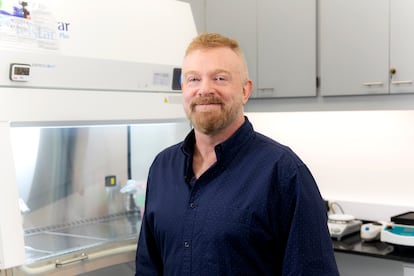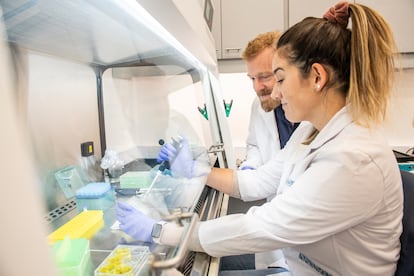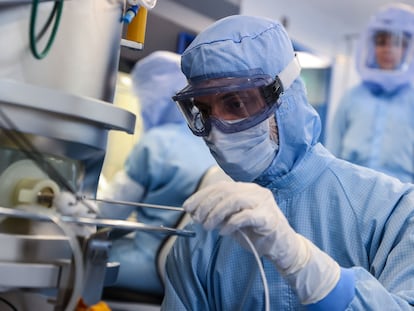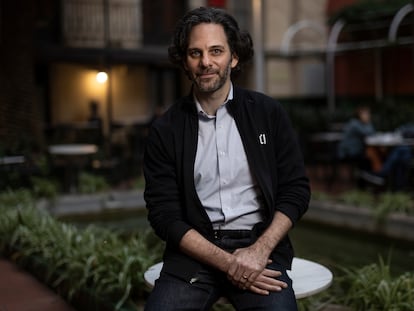The Argentine who is revolutionizing cancer treatments: ‘If you want to cut spending, science is not the place to do it’
Gabriel Rabinovich revealed the function of galectins, a protein of the immune system that is key to understanding the development of tumors

When he was 13 years old, Gabriel Rabinovich received Cosmos, by Carl Sagan, as a gift. A concept from this book would mark him forever: that life is inextricably linked to science, because those who devote themselves to science have a better chance of surviving and transforming society. Ten years after receiving that present from his sister, now holding a degree in chemical sciences, Rabinovich made a significant discovery when he revealed the role of galectins, a protein of the immune system that is key to understanding the development of tumors and autoimmune diseases and to creating new therapies and treatments that, after 30 years of research, are closer to becoming a reality.
Months ago, the researcher and director of the Laboratory of Immunology of the Institute of Biology and Experimental Medicine, dependent on the National Council for Scientific and Technical Research (CONICET), launched Galtec, a public-private biotechnology company that will develop medications and treatments for cancer and other conditions, whose clinical stage testing in humans will begin in 2026.
Rabinovich — who has just received the Diamond Konex award and has published more than 300 papers and studies — is enthusiastic about the prospect of a future with “more personalized” treatments, and believes that his developments could help give millions of patients “another chance.” He also reflects on the current situation of science in Argentina, amid the threats from the new government of ultra-conservative Javier Milei regarding cuts in the fields of scientific and technological research, and the privatization or closure of CONICET.
Question. What is Galtec? What will its purpose be?
Answer. It is a technology-based company created after 30 years of research in basic science. Its purpose is to translate discoveries linked to galectins into drugs for cancer and autoimmune diseases. In 1993, we identified galectin-1, a protein whose purpose we did not know at the time. Now we know that it has the ability to negatively regulate the immune response: when we are infected by a virus, or a tumor grows, an army of lymphocytes is immediately generated in order for the body to defend itself, but at some point that army must return to normal. The protein returns the cells to normal, but with a double paradigm, because in some cases it is good and in other conditions it is bad.
Q. When is it good, and when is it bad?
A. It is a “good guy” when it eliminates lymphocytes so that the excess does not cause an autoimmune disease. In those cases, galectin-1 must be stimulated. But in the case of tumors it is the “bad guy,” because when they grow they create escape mechanisms for the immune system. Tumors multiply this protein, which eliminates the lymphocyte, and in this case must be blocked.
After 30 doctoral theses, we set out to build technology that allows galectin-1 to be eliminated in cancer and stimulated in autoimmune diseases. For cancer, we created a monoclonal antibody that neutralizes it: when we inject it into animal models, the immune system immediately eliminates the tumor. In the other case, it eliminates the “extra” lymphocytes, and the system returns to normal.

Q. How did the discovery come about?
A. I was a biochemistry student and had to do laboratory practices. I wanted immunology, which always fascinated me, but it was full, so they sent me to study the chicken retina. I became tremendously depressed: I was young, 23 years old, and I wanted to cure cancer. However, it was thanks to that, that I met my mentor, Carlos Landa, who suggested I make antibodies for some proteins in the chicken retina. He taught me for a whole year, and when the course was over he gave me some antibodies as a keepsake. I gave them to my mom to keep in the freezer at home. When I finished my degree I was frustrated, I wasn’t getting any scholarships, I wasn’t sure whether to continue doing science or not, and then one day I remembered those antibodies and decided to purify them: when we added them to lymphocytes, they died. Then I thought, “Either I’m doing something wrong, or I just discovered something.”
Q. What is the scope of your research?
A. In human cells from patients, galectin-1 eliminates T lymphocytes, and the same thing happens in autoimmune diseases. We work with experimental models or with patient cells, through an ethics committee. We saw this paradigm, that it can be blocked in cancer or increased in autoimmune diseases, in almost all autoimmune diseases, in cancer, and it was also analyzed in other laboratories that began to research in other countries. This gave us strength to generate therapies; this is how the monoclonal antibody and the galectin-1 variant emerged, after 320 studies. In 2010, we began to reflect upon what we were doing and they suggested starting a technology-based company to create products that are tested in the clinical phase of patients and develop them so that they are approved as therapies.
Q. What is the process like, until it becomes a drug that reaches a cancer patient?
A. We achieved the ideal antibody, which increases the immune response and blocks vascularization. We set out to look for investments and, although we do have state support, we also receive funds from the White Lions investment group. The goal is to transform these technologies into pharmaceutical products through the Good Manufacturing Practice system, to be able to present them to regulatory authorities such as the FDA (United States), the EMA (Europe) or the ANMAT (Argentina). We think that in two and a half years we can be ready to carry out clinical stage 1 tests on patients.
Q. Could this be the definitive cure for cancer?
A. I wouldn’t say 100% cure. Cancer is many diseases; some are already treatable and curable. But it is one more tool for the patients. The first cancer we want to target is colorectal. There are 1,200,000 cases a year; it has grown a lot, especially among young people. Only 15% benefit from classic immunotherapy, but 85% do not, so we want to raise the bar. It can be a set of therapies: conventional immunotherapy together with our development.
We don’t think this is going to save the world and there will be no more need for chemotherapy; the point is to increase the possibilities, because the big problem with cancer therapies is that patients improve and then at one point they become resistant to the therapy. In those cases, we want to have another possibility, instead of having to tell a patient: “You’re out of chances.”
Q. Will they be affordable medications?
A. The galectin-1 variant is cheaper; the monoclonal antibody is more expensive. We made an agreement with CONICET, which licenses the patents to be able to operate and raise funds. We give money back to CONICET at different milestones. But we established a price agreement, so that at least in Argentina people can have access, with affordable prices.
Q. How will treatments for cancer and autoimmune diseases be in the next decade?
A. More personalized — not for each patient, but for specific groups. Each tumor and each autoimmune disease depends on each patient and their microenvironment. We must identify the escape mechanisms of each tumor: not all enemies arrive with the same weapons. We must have an arsenal of molecules and tools that allow blocking. Precision medicine makes it possible to see if a patient will benefit from a certain therapy or if they might be harmed.

Q. Throughout your life you have faced situations where family members or close friends had cancer. Do you look at your research from a different perspective because of that?
A. I live it with a lot of pride, but also with a lot of adrenaline. It is a challenge and a very big commitment. At one point it was a dream, now I think it is a moment of great responsibility and commitment. If I leave this world, I wouldn’t want it to be before a patient receives the serum.
Q. What is your take on the present state of Argentina’s science, amid the change of government and the warnings that the new administration will cut budgets in science and technology?
A. Many things that are being said are impossible to achieve. Without basic science, it is impossible to achieve a result that may interest a private company. There must be a very great respect and consolidation of high-quality, rigorous, transformative science, to be able to work in different areas, just like with public universities. If you want to cut spending, science is not the place to do it; we must do more science precisely because we are poor.
Q. 30 years have passed since the discovery of galectin-1. How do you envision the next few years?
A. I definitely want to bring this development to patients. I imagine a medicine with more therapeutic options, with more opportunities. I have collaborations in Spain thanks to the call of Josep Tabernero, director of Oncology at Hospital Vall D’Hebron and the CaixaResearch Institute, to be able to advance in the clinical stages of this project and so that they can be carried out jointly between Argentina and Spain. Sometimes I think that I didn’t choose galectin, but that it chose me. The moment I see that the treatment works, improves quality of life and brings a substantial change, I will undoubtedly be very excited.
Sign up for our weekly newsletter to get more English-language news coverage from EL PAÍS USA Edition
Tu suscripción se está usando en otro dispositivo
¿Quieres añadir otro usuario a tu suscripción?
Si continúas leyendo en este dispositivo, no se podrá leer en el otro.
FlechaTu suscripción se está usando en otro dispositivo y solo puedes acceder a EL PAÍS desde un dispositivo a la vez.
Si quieres compartir tu cuenta, cambia tu suscripción a la modalidad Premium, así podrás añadir otro usuario. Cada uno accederá con su propia cuenta de email, lo que os permitirá personalizar vuestra experiencia en EL PAÍS.
¿Tienes una suscripción de empresa? Accede aquí para contratar más cuentas.
En el caso de no saber quién está usando tu cuenta, te recomendamos cambiar tu contraseña aquí.
Si decides continuar compartiendo tu cuenta, este mensaje se mostrará en tu dispositivo y en el de la otra persona que está usando tu cuenta de forma indefinida, afectando a tu experiencia de lectura. Puedes consultar aquí los términos y condiciones de la suscripción digital.
More information
Archived In
Últimas noticias
Most viewed
- Sinaloa Cartel war is taking its toll on Los Chapitos
- Reinhard Genzel, Nobel laureate in physics: ‘One-minute videos will never give you the truth’
- Oona Chaplin: ‘I told James Cameron that I was living in a treehouse and starting a permaculture project with a friend’
- Why the price of coffee has skyrocketed: from Brazilian plantations to specialty coffee houses
- David King, chemist: ‘There are scientists studying how to cool the planet; nobody should stop these experiments from happening’










































